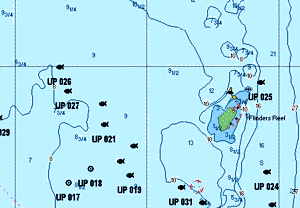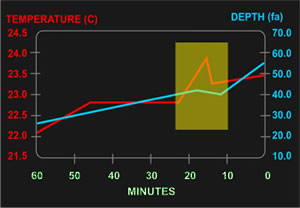1. Let's Go! Getting There
Between The Lines - Ch: 12 Fighting Fish
|
All the preparations are done, gear checked, the boat set up and ready for action, the theory, exercises, training, team meetings, grinding through manuals and gear testing complete. The old tried and true cliché: "99% of success is achieved before you leave the dock" is quite accurate as the preceding pages show. It is now my pleasure to say "Welcome aboard, now let's go trolling! It's about time and I'm certainly looking forward to this as much as you are!" With all that's gone before we have a pretty good idea of what, when, how and even who, so the rest is pretty easy. It's about time something was! In the following we'll go through what I'd like to think is a typical day out fishing, during a season when we can reasonably expect some action. The size of the boat or number of crew is not relevant in this discussion as each boat is unique, requiring specific routines. It is probably around dawn that the crew gathers to load the boat and get underway. Because it's early, and the brain is likely to be in low gear, it's preferable to have a pretty set routine of who puts what on the boat and where it all goes. Vid 1 The skipper generally arrives at the boat first checking the engine's oil and water, belts and goes on to check boat bilges, safety gear and electronics. (Vid 1) Vid 2 Once the skipper finishes the checks the gear is loaded: (Vid 2) ice, drinks, food, camera gear etc. The crew then goes through their own checklist of getting out the lures likely to be used. This is the best time to give them a quick once over and sharpen any dull hooks and replace damaged leaders, although the lures, hooks and leaders will be checked again as they are deployed. (Vid 3) Vid 3 Any tools such as pliers, knives and hook-out guns are put where they are both easily accessible and out of the way and then checked and sprayed with lubricant if needed. Gloves are put somewhere handy, and tags and tag poles checked and loaded. (Vid 4) Vid 4 Once the gear that is likely to be used during the trip is checked and positioned any visitors on the boat should be briefed on safety gear and emergency procedures. After this quick tour and discussion spend a little time getting to know the visitors and run them through their role throughout the day and it is just as important they know what you don't want them to do. If they are likely to get seasick ensure they have taken medication. All this is generally done before leaving the dock. Once you are underway, waiting for the engines to warm up, it's a good time to check the drags on the reels. (Vid 5) Vid 5 You can now work out the strike order and get the harness and gimbal belt or the fighting chair and seat harness adjusted for the first angler. By the time all the drags are checked and fighting systems adjusted the engines should be warm and it's time to get out there. As you reach the ocean make a radio call to log on to your local organisation giving them the information they request. (Vid 6) Don't forget to call them if you are extending your time and when you get back in sign off with the same organisation. Vid 6 It is certainly great to get out there, but it's even better to have a reasonable idea of where you are going. Most destinations are based on various criteria, much of which has been dealt with previously. All in all, the choice of where to go is where you think your best chances are, based on criteria such as examining charts, recent reports, historical areas where the fish regularly show up through various times of the season and SST charts. There is often some consideration of the weather, enabling you to fish as long as you wish to. For example, if the forecast is for southerly winds in the morning and northeast in the afternoon you are certainly going to be more comfortable going to northern grounds and coming home with the wind. Other factors may override this decision, such as, if the grounds to the south are known to be holding fish and the northern grounds are currently regarded as barren of life. Regardless of what you base your decision on where your destination is, you should start scanning for signs of life and possibilities of encountering fish as soon as you leave the harbour. Keep an eye on the sea temperature gauge for any major fluctuations and the depth sounder for signs of life or structure. Although you may have looked at charts for the area many times before, you may see new kinks on GPS chartplotters using additional charting software such as C-Map (Fig 1) which are worth investigating. If there are any signs worth noting, you may either stop to fish then and there, or plot it for future reference. Using your eyes to spot signs on the way to the destination is also critical.
The importance of trying to find a likely area worth fishing on the way to the destination cannot be overemphasised. The time you are usually travelling, which is often just after dawn, is one of the best times to fish. If you are travelling any great distance then you may well get to your destination after the best time of the day. One of the most sought-after areas to find is the first major temperature break. (Fig 2) If there are other signs such as baitfish, current lines, hovering or diving birds it is certainly worth further investigation. While we are on the subject of the best time of the day we might just break away from the main topic to look at some of the factors that contribute to the best times to fish. Just as any other animal on land or in the sea the ocean predators have a full spectrum of feeding habits from not eating at all, grazing and all-out gluttony attacks on anything that comes within range. The periods of active feeding often coincide with certain periods through the season such as moon phases, peaking three to five days either side of the new and full moon. Tide changes also affect feeding with peaks at the tide changes. Changes in weather reflected by significant drops or increases in barometric pressure also signal peak feeding periods. The time of day such as dawn and dusk are also peak periods. Getting as many of these various factors happening at the same time is as important to a successful day's fishing as finding temperature changes and other signs of life. There are many ways of lining up these various factors, the most important of which is the solunar tables which are a traditional combination of moon phases, tides and often sunrise and sunset. These tables are also available in other formats such as digital watches. By entering your current GPS position they will work out and display the best feeding times of the day. Having some idea on when the peak feeding times are likely to be, is worth noting as you may be travelling to your destination through one of these periods and miss the bite, or you have planned to get wherever you're going to be there in time to take advantage of the period. If you are travelling to your destination through a non-feeding time and see signs such as temperature changes, current lines, birds etc that are not active, mark the area on the GPS and keep it in reserve as it may well be worth revisiting at the right time if there is more obvious potential than at your proposed destination. How much effort you put into deciding where to start fishing is up to you. Our standard tournament procedure is to arrive at our proposed fishing area with enough time to get back to any of the areas that may appear to be better choices, which means have twice as much time to get there as needed. If the area looks promising we use the time to mark the best spots in the area or if it is barren we have the time to get back to any of the likely areas we marked on the way out. The concept that lures are used to cover as much ground as possible is very misleading. Fish are not randomly spread throughout the ocean. As with every other fish species, they are concentrated within quite small areas. Using lures allows you to effectively work over an area that is likely to hold fish. |







